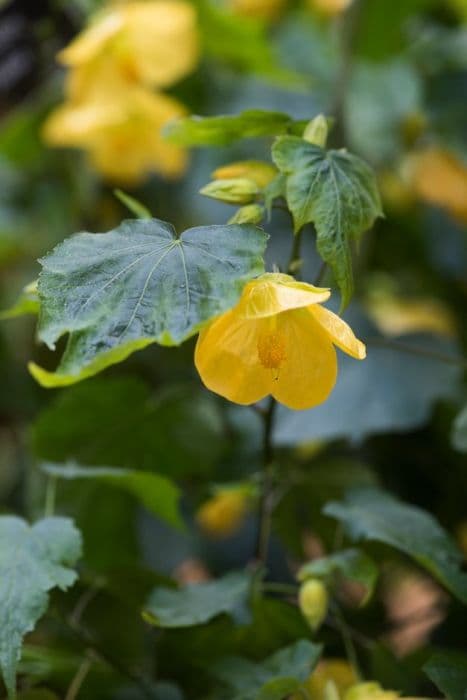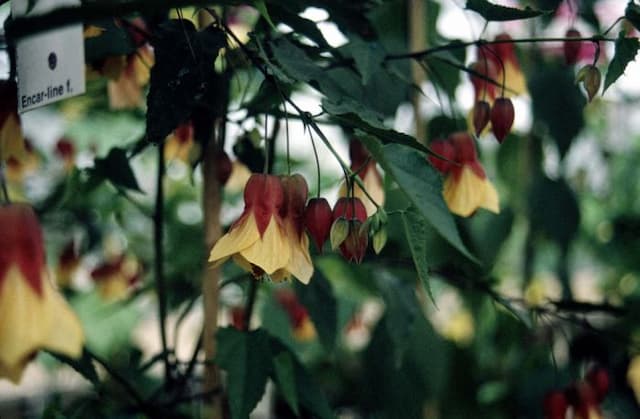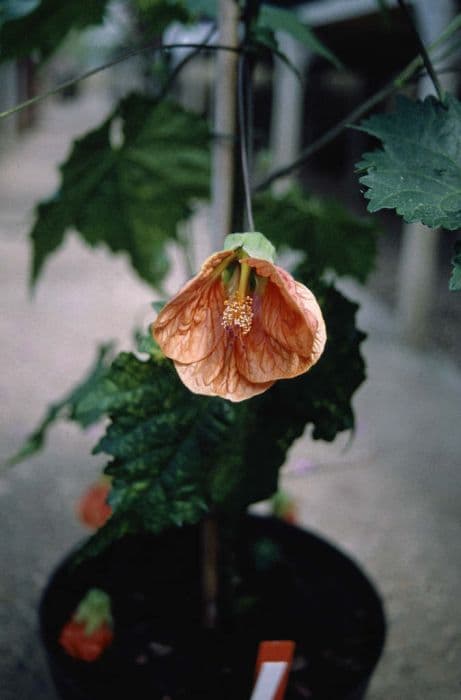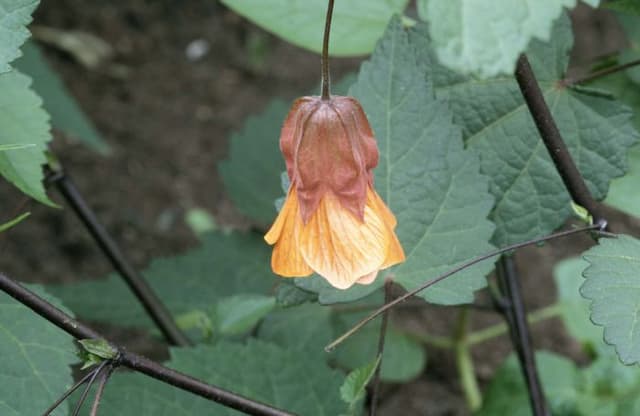Hollyhock 'Mars Magic' Alcea rosea 'Mars Magic' (Spotlight Series)

ABOUT
'Mars Magic' is a herbaceous perennial producing a mound of soft, five-lobed foliage and 1.8m tall spires of large, rich ruby-red flowers in summer
About this plant
 Names
NamesFamily
Malvaceae.
Synonyms
Hollyhock, Rose Mallow, Garden Hollyhock.
Common names
Alcea rosea 'Mars Magic' (Spotlight Series).
 Characteristics
CharacteristicsLife cycle
Perennials
Foliage type
Deciduous
Color of leaves
Green
Flower color
Red
Height
5-6 feet (1.5-1.8 meters)
Spread
2 feet (0.6 meters)
Plant type
Herb
Hardiness zones
3-9
Native area
Asia
Benefits
 General Benefits
General Benefits- Attracts Pollinators: Alcea rosea 'Mars Magic' is known for drawing in bees, butterflies, and hummingbirds, which is beneficial for pollination in the garden.
- Ornamental Value: With its bold red flowers, this hollyhock is a striking ornamental plant that adds height and color to garden borders and beds.
- Cottage Garden Appeal: This plant is ideal for creating a classic cottage garden look, adding to the aesthetic appeal of such designed spaces.
- Drought Tolerance: Once established, it exhibits some drought tolerance, making it suitable for gardens with less frequent watering schedules.
- Easy to Grow: Hollyhocks are generally easy to care for and can grow in a range of soil types, though they prefer well-drained soil.
- Seasonal Interest: They bloom in summer, providing seasonal interest and color when many other plants have finished flowering.
- Vertical Accent: Hollyhocks are tall plants that can provide vertical accent in the landscape, making them great for the back of borders or against walls and fences.
- Wildlife Habitat: The plant can serve as a source of food and habitat for wildlife, beyond just pollinators.
- Self-Seeding: Alcea rosea 'Mars Magic' can self-seed under the right conditions, leading to new plants in subsequent years without additional planting.
- Historical Plant: Hollyhocks have a long history of cultivation and can add an element of tradition and nostalgia to gardens.
 Medical Properties
Medical Properties- This plant is not used for medical purposes.
 Air-purifying Qualities
Air-purifying QualitiesThis plant is not specifically known for air purifying qualities.
 Other Uses
Other Uses- Alcea rosea 'Mars Magic' can be used in fabric dyeing, providing a source of natural color that ranges from light to dark pink, depending on the mordant used.
- The crushed petals of the hollyhock can be mixed with water to create a natural ink for calligraphy or artwork, offering a subtle pink hue.
- Dried petals of the hollyhock can be incorporated into paper making, adding a floral touch and specks of color to handmade papers.
- The tall, sturdy stalks of hollyhocks can be used in the garden to provide support for climbing plants or to create natural trellises.
- Hollyhock flowers are edible and can be used to garnish salads, desserts, or as a colorful addition to ice cubes for decorative drinks.
- The blooms can be pressed and used in botanical prints or in craft projects, such as card making or decoupage.
- Hollyhocks can be planted to create a natural play area for children, forming "flower rooms" with their tall stalks and large blooms.
- The seed pods of Alcea rosea 'Mars Magic' can be dried and used in rattles or as noisemakers for children's toys or musical instruments.
- Hollyhock blooms can be used as molds for candle making, with the intricate petal patterns creating unique and detailed candle shapes.
- Dried hollyhock flowers can be used in potpourri mixes to add color and a mild, floral fragrance to living spaces.
Interesting Facts
 Feng Shui
Feng ShuiThe Hollyhock is not used in Feng Shui practice.
 Zodiac Sign Compitability
Zodiac Sign CompitabilityThe Hollyhock is not used in astrology practice.
 Plant Symbolism
Plant Symbolism- Fertility: Being a prolific bloomer, the plant is often associated with fertility and the abundance of life.
- Resilience: Because of its ability to grow in a variety of soils, it symbolizes resilience and adaptability.
- Beauty: With its large, colorful blossoms, the plant represents beauty and is often used in decorative displays.
- Healing: Historically, the plant has been used for medicinal purposes, symbolizing healing and the restoration of health.
 Water
WaterHollyhocks should be watered deeply, ensuring the soil is moist but not waterlogged. They typically require about 1 to 2 inches of water per week, depending on weather conditions. During hot, dry periods, additional watering may be necessary to maintain moisture. It's best to water at the base of the plant to avoid wetting the foliage, which can lead to disease. In general, giving the plants about 1.5 gallons of water every two weeks should suffice, but always adjust based on rainfall and temperature.
 Light
LightHollyhocks prefer full sun with at least 6 hours of direct sunlight each day. The best spot for Alcea rosea 'Mars Magic' is in an open area that receives ample sunlight and is protected from strong winds. Partial shade is acceptable but may reduce the plant's vigor and flowering potential.
 Temperature
TemperatureHollyhocks thrive in a range of temperatures but perform best when daytime temperatures are between 60°F and 90°F. They can survive minimum temperatures down to about 20°F, making them suitable for many temperate climates. The ideal temperature range for robust growth and flowering is between 70°F and 85°F.
 Pruning
PruningPruning Hollyhocks helps to encourage bushier growth and more blooms. Prune in late winter or early spring before new growth begins by cutting back any dead or damaged stalks. Deadhead spent flowers regularly to promote continuous blooming. After the blooming season, cut back the stalks to ground level to help control rust and other fungal diseases.
 Cleaning
CleaningAs needed
 Soil
SoilHollyhocks prefer well-draining, fertile soil with a pH of around 6.0 to 8.0. A mix of loam, peat moss, and compost is ideal for providing the necessary nutrients and drainage. Ensure the soil is enriched with organic matter to support their tall growth.
 Repotting
RepottingHollyhocks, being biennial or short-lived perennials, do not typically require frequent repotting. They prefer to be left undisturbed and can be allowed to self-seed in the garden.
 Humidity & Misting
Humidity & MistingHollyhocks are tolerant of a range of humidity levels and do not require any special humidity conditions. They thrive in outdoor environments where the humidity is natural and not controlled.
 Suitable locations
Suitable locationsIndoor
Provide full sun and well-draining soil.
Outdoor
Plant in full sun, enrich soil, space 18 inches apart.
Hardiness zone
3-9 USDA
 Life cycle
Life cycle'Mars Magic' Hollyhock, a biennial or short-lived perennial, begins its life cycle with seed germination, usually in late summer to early fall. The first year primarily focuses on vegetative growth forming a low rosette of leaves. As the plant enters its second year, it elongates a sturdy flowering stalk that can reach up to 5-6 feet tall, adorned with large, vivid red single flowers blooming in mid to late summer. Following pollination, typically by bees and butterflies, the plant sets seed in round capsules. After seed dispersal, the parent plant often dies, but new plants may arise from the self-sown seeds or the roots may sprout again if conditions are amiable. Overwintering can occur in milder climates, where they may behave more like perennials, producing new shoots in the subsequent spring for another flowering cycle.
 Propogation
PropogationPropogation time
Spring to Summer
The most popular method of propagation for the Hollyhock 'Mars Magic' is by seed. Hollyhocks are biennials or short-lived perennials, which means they're adept at seed propagation. To propagate these plants by seeds, one should start indoors about 6-8 weeks before the last expected frost. Sow the seeds at a depth of about 1/4 inch (about 6 millimeters) in a well-draining soil mix and keep them in a warm area, aiming for a germination temperature around 70°F (21°C). The seeds typically germinate in 10-14 days. Once seedlings have developed true leaves and there is no more danger of frost, they can be transplanted outside into a sunny spot with well-draining soil.





![Abutilon [Yellow Trumpet]](/_next/image?url=https%3A%2F%2Fplants-admin.emdemapps.com%2Fimages%2Fplants%2F%2Fimages%2F604b5caa8b4fb.png&w=640&q=75)


